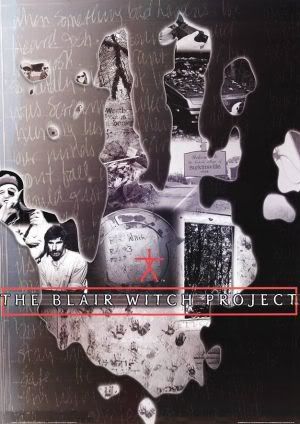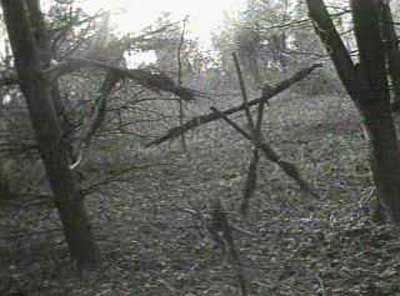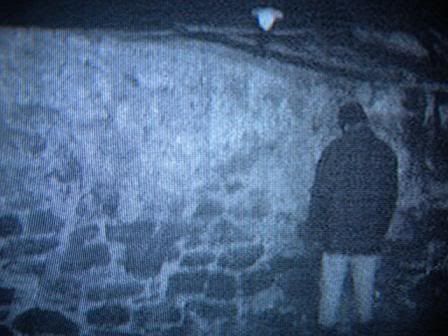 |
| FIG.1 |
Producer(s): Robin Cowie, Gregg Hale
Cast: Heather Donahue, Joshua Leonard, Michel C. Williams
Year: 1999
The Blair Witch Project (BWP) is am American horror film which is pieced together from an amateur footage found in the woods and is presented as a documentary. It is a cross-media phenomenon between the web and cinema, which reinvented film marketing. The films tells the story of three film maker students, Heather, Josh and Mike who set off to film a documentary about a local myth of The Blair Witch. Their journey leads them to the Black Hills near Burkittsville, Maryland were they got lost and never found. Despite its very low budget, poor technology (the whole film was filmed with low quality hand held cameras) and no use of special effects the film earned a lot of money and received a lot of positive comments. "The BWP and its seemingly overnight success is far more complex, and that success contains a far larger lesson about what is happening in the American film industry, particularly in its marketing efforts, that would initially seem to be the case." ( Highly, Weinstock.2004:37) The film earns its place in film history as the first Internet-driven theatrical release with its pre-existing website which had been set up by the film-makers. The website was filled with evidence and photographs of the protagonists' remnants found in the woods, police records, history of The Blair Witch and journals which posed an enigma around the story: Did it happen or not?
What made the film so distinctive was the fact that it based on reality and was not relying on the power of computer generated visual effects. The film starts off with introducing us to the film-maker protagonists. As 3 young students their banter is appropriately juvenile: the drink beer, swear a lot and are in general not taking life as seriously as an adult would. They are carefree and full of energy, ready to live their life and go through adventures. This representation of the main characters as general everyday teenagers brings the audience closer to the film as it's more based on reality. Myrick and Sanchez were aware of what can provoke fear and that was basing it on examples of every day life, with real characters, real locations, real stories and real fear: the fear of the unknown.
The film then prepares us for what is about to come as the teenagers interview the locals about the mystery surrounding this myth. The interviewees talk about a Witch with a hairy body and long black hair and about a man who claimed that her spirit forced him torture seven children and made them face the wall as he was murdering the rest. All those stories instantly create a sense of fear to the viewer and makes him visualise the Witch herself. Even a small child was covering his mother's mouth as she was talking about the myth, showing that the story was used as something to scare children and make them go to sleep early at night. "The eponymous figure at the heart of the 'project seems shadowy at best . But her legend does bear a determined meaning , heralded by the little girl's reaction: it terrifies children." (Lewis.2001:113) .Then again the story doesn't show the Witch at all which leaves the viewer make his own decision on the Witch's appearance and attitude.
 |
| FIG.2 |
After that the 3 teenagers go off hiking in the woods to gather more information. On their first days they enjoy their "re-attachment" with nature. As the film proceeds the footage becomes increasingly hand-held and shows the point of view of the camera. The characters are running, breathing heavily, as they walk up hills and go through tall vegetation. After a few nights of hearing strange screams in the woods and discovering strange piles of rocks placed around their tents they become concerned of their safety, yet they are still intrigued to uncover the story. But the pile of rocks is followed by strange shapes made out of sticks hanging from trees, something that suggest some kind of voodoo ceremonies taking place in the woods (FIG.2). As the days past the teenagers try to find their way out of the woods but realised they've been going around circles. The feeling of being, lost, hungry and haunted makes the viewers show sympathy towards the characters while the constant black shots at night with just the sound of their whispering voices in the tents and the screams from the outside brings them in the same position as the characters.
 |
| FIG.3: Heather's confession. |
One of the most touching, climax (and memorable) scenes is Heather's confession to her family in front of the camera. With only her eyes being visible to the camera, which are the most expressive feature on the human face, Heather expresses the situation she's going trough and talks about how much she loves her parents knowing that threat is approaching and might even die. Probably the most shocking scene of the film is the last image of Mike facing the wall (FIG.4) captured by the camera seconds before Heather got knocked down unconscious/dead. The curt ending leaves the mystery still unsolved which creates suspense.
 |
| FIG.4: The last scene. |
List of Illustrations
FIG.1: Film Poster At: http://www.movieposterdb.com/poster/90fc922f (accessed on 26/2/2011)
FIG.2: Film Still At: http://cinemastyles.blogspot.com/2010/10/defending-unknown-blair-witch-project.html (accessed on 26/2/2011)
FIG.3: Film Still At: http://all-movie-goofs.info/blair-witch-project-mistakes.html (accessed on 26/2/2011)
FIG.4: Film Still At: http://www.moviemobsters.com/2009/10/15/top-ten-ghost-movies/ (accessed on 26/2/2011)
Bibliography
Highly Sarah and Weinstock Jeffrey Andrew.(2004).Nothing that is: millennial cinema
and the Blair witch controversies. Michigan: Wayne State University Press
Lewis Jon.(2001).The end of cinema as we know it: American film in the nineties. United
Kingdom:Pluto Press

One of the review on the make of a movie introduced by Blair Witch Project.
ReplyDelete